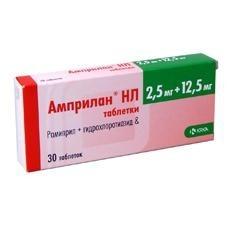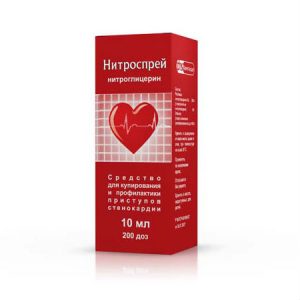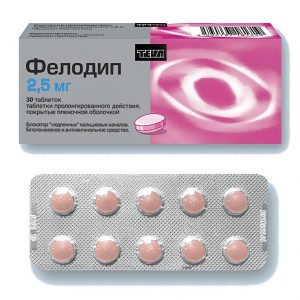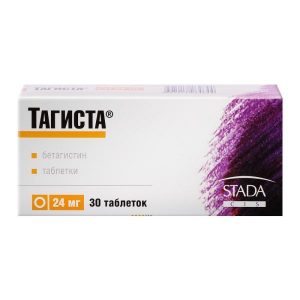Description
Release form
Tablets.
Packing
30 pcs.
The pharmacological action of
ACE catalyzes the conversion of angiotensin I to angiotensin II. ACE is identical to kininase, an enzyme that catalyzes the breakdown of bradykinin. ACE blockade leads to a decrease in the concentration of angiotensin II, an increase in plasma renin activity, an increase in the effect of bradykinin and an increase in the secretion of aldosterone, which may cause an increase in the level of serum potassium. The antihypertensive and hemodynamic effects of ramipril in patients with arterial hypertension are the result of vasodilation and a decrease in OPS, which in turn gradually reduces blood pressure. Heart rate usually does not change. With prolonged therapy, left ventricular hypertrophy decreases without negatively affecting heart function. The antihypertensive effect after taking one dose of the drug inside appears in 1-2 hours, reaches a maximum after 3-6 hours and persists for 24 hours.
Ramipril is effective in the treatment of heart failure. In patients with signs of heart failure after a myocardial infarction, ramipril reduces the risk of sudden death, the progression of heart failure and reduces the number of hospitalizations for an exacerbation of heart failure. Both in patients with and without diabetes, the drug significantly reduces the existing microalbuminuria and the risk of developing nephropathy. These effects are noted in patients with both elevated and normal blood pressure.
Indications
Arterial hypertension.
Chronic heart failure (as part of combination therapy), incl. developed on the 2nd 9th day after myocardial infarction.
Diabetic nephropathy and nephropathy in the presence of chronic diffuse kidney diseases (preclinical and clinical stages), including chronic glomerulonephritis with severe proteinuria.
Reducing the risk of myocardial infarction, stroke and cardiovascular mortality in patients with high cardiovascular risk, including patients with confirmed coronary heart disease (with or without a history of myocardial infarction), patients who underwent percutaneous transluminal coronary angioplasty, coronary bypass surgery, and a history of stroke with occlusive lesions of the peripheral arteries.
Contraindications
Hypersensitivity to ramipril and any other component of the drug or other ACE inhibitors.
History of angioedema (hereditary, idiopathic or angioedema due to ACE inhibitors).
Hemodynamically significant bilateral renal artery stenosis.
Stenosis of a single kidney artery.
Condition after kidney transplantation.
Hemodialysis.
Renal failure (Cl creatinine
Hemodynamically significant aortic and / or mitral stenosis (risk of excessive decrease in blood pressure followed by impaired renal function).
Hypertrophic obstructive cardiomyopathy (GOKMP).
Chronic heart failure with less than one stage of arterial decompensation 90 mmHg) or unstable hemodynamics.
Primary hyperaldosteronism.
Galactose intolerance, lactase deficiency or glucose-galactose malabsorption syndrome.srdl kp Nephropathy, which is treated with GCS, NSAIDs, immunomodulators and / or cytostatics.
Pregnancy.
Lactation.
Age 18 years (efficacy and safety not established).
Caution: severe lesions of the coronary and cerebral arteries (risk of decreased blood flow with an excessive decrease in blood pressure) malignant arterial hypertension unstable angina pectoris aortic and / or mitral stenosis severe ventricular arrhythmias chronic heart failure (NYHA functional class IV) decompensated pulmonary heart renal and / or liver failure hyperkalemia hyponatremia (including against the background of diuretics and diets with a restriction of salt intake) conditions accompanied given by a decrease in bcc, incl. diarrhea, vomiting systemic connective tissue diseases diabetes mellitus inhibition of bone marrow hematopoiesis elderly hemodialysis using high-flow polyacrylonitrile membranes – the risk of anaphylactoid reactions before LDL apheresis while desensitizing therapy with allergens (e.g. hymenoptera venom).
Use during pregnancy and lactation
Amprilan ® is contraindicated during pregnancy, as it can have an adverse effect on the fetus (including impaired renal function, hyperkalemia, hypoplasia of the bones of the skull, hypoplasia of the lungs). Therefore, before using Amprilan ® in women of childbearing age, pregnancy should be excluded. When diagnosing pregnancy, taking Amprilan ® should be discontinued as soon as possible.
If it is necessary to use Amprilan ® during lactation, breast-feeding should be discontinued.
Special instructions
At the beginning of treatment, it is necessary to evaluate renal function. It is necessary to carefully monitor renal function in patients with impaired renal function, heart failure, bilateral renal artery stenosis or stenosis of a single kidney artery, as well as in patients after kidney transplantation.
Hepatic insufficiency
In rare cases, with the use of ACE inhibitors, cholestatic jaundice occurs, with the progression of which fulminant liver necrosis develops, sometimes with a fatal outcome. If jaundice occurs or a significant increase in hepatic transaminase activity occurs while taking ACE inhibitors, the use of Amprilan ® should be discontinued.
In patients with uncomplicated arterial hypertension, symptomatic arterial hypotension rarely develops after taking the first dose of the drug. The risk of developing arterial hypotension is increased in the following patients: With severe heart failure: treatment begins with the lowest possible dose of Amprilan ® (1.25 mg).
Taking diuretics: if possible, diuretic should be canceled in advance or its dose reduced. Treatment is started with the minimum dose of Amprilan ® (1.25 mg).
At risk of developing hypovolemia due to insufficient fluid intake, diarrhea, vomiting or with excessive sweating in conditions of insufficient compensation for the loss of salt and liquid. It is usually recommended that BCC be adjusted before treatment, but if these conditions become clinically significant, treatment with Amprilan ® can be started and / or continued with a minimum dose (1.25 mg) and under medical supervision.
Aortic stenosis / mitral stenosis / GOKMP
ACE inhibitors should be used with caution in patients with left ventricular outflow tract obstruction and in aortic and / or mitral stenosis.
Neutropenia / agranulocytosis
Patients taking ACE inhibitors may develop neutropenia / agranulocytosis, thrombocytopenia, and anemia. In patients with normal renal function, in the absence of other complications, neutropenia develops rarely and disappears on its own after the withdrawal of ACE inhibitors.
Ramipril should be used with great caution in patients with connective tissue diseases who are simultaneously receiving immunosuppressive therapy, allopurinol or procainamide, especially with existing renal impairment. Such patients may develop severe infections that are not amenable to intensive antibiotic therapy. In the case of ramipril, it is recommended to periodically monitor the number of white blood cells in the blood. The patient should be warned that in case of any signs of an infectious disease (sore throat, fever), you should immediately consult a doctor.
Hyperkalemia
May develop during treatment with ACE inhibitors, including and ramipril. Risk factors for hyperkalemia are renal failure, old age, diabetes mellitus, some concomitant conditions (decreased BCC, acute heart failure at the stage of decompensation, metabolic acidosis), concomitant use of potassium-sparing diuretics (such as spironolactone, eplerenone, triamteren, amyloride), as well as drugs potassium or potassium-containing substitutes for edible salt and the use of other drugs that increase the potassium content in blood plasma (for example, heparin). Hyperkalemia can lead to serious cardiac arrhythmias, sometimes fatal.
Potassium-sparing diuretics and potassium preparations
Combined use of Amprilan ® and potassium-sparing diuretics, as well as potassium preparations and potassium-containing salt substitutes are not recommended.
Surgical interventions / general anesthesia
The use of ACE inhibitors in patients undergoing surgery with general anesthesia can lead to a marked decrease in blood pressure, especially when using general anesthesia agents that have a hypotensive effect.
It is recommended that you stop taking ACE inhibitors, including ramipril, 12 hours before surgery, warning the anesthetist about the use of ACE inhibitors.
Cough
Dry cough may occur during therapy with an ACE inhibitor, which disappears after discontinuation of this group of drugs. When a dry cough appears, one should remember the possible connection of this symptom with the use of an ACE inhibitor.
Anaphylactoid reactions during desensitization procedures
There are some reports of the development of prolonged, life-threatening anaphylactoid reactions in patients receiving ACE inhibitors during desensitizing therapy with hymenoptera venom (bees, wasps). ACE inhibitors should be used with caution in patients prone to allergic reactions undergoing desensitization procedures. The administration of an ACE inhibitor should be avoided in patients receiving immunotherapy with hymenoptera venom. Nevertheless, the development of anaphylactoid reactions can be avoided by temporarily disabling the ACE inhibitor at least 24 hours before the start of the desensitization procedure.
Anaphylactoid reactions during LDL apheresis
In rare cases, in patients receiving ACE inhibitors, During LDL apheresis using dextran sulfate, life-threatening anaphylactoid reactions may develop. To prevent an anaphylactoid reaction, ACE inhibitor therapy should be discontinued before each LDL apheresis procedure using high-flow membranes.
Hemodialysis
Anaphylactoid reactions have been observed in patients receiving ACE inhibitors with hemodialysis using high-flow membranes (eg AN69 ®). Therefore, it is desirable to use a membrane of a different type or to use a hypotensive drug of another pharmacotherapeutic group.
Influence on the ability to drive a car or perform work, requiring increased speed of physical and mental reactions
During treatment, care must be taken during classes of potentially dangerous activities that require an increased concentration of attention and speed of psychomotor reactions, because dizziness, drowsiness, confusion, and other side effects are possible.
Composition
Active ingredient: ramipril – 2.5 mg, hydrochlorothiazide 12.5.
Excipients: sodium bicarbonate – 2.5 mg lactose monohydrate – 155 mg sodium croscarmellose – 4 mg pregelatinized starch – 30 mg sodium stearyl fumarate – 2 mg, dye mixture PB 22886 yellow (lactose monohydrate, yellow iron oxide dye (E172) – 4 mg
Side effects
Classification of the frequency of development of side effects (WHO): Very often -? 1/10.
Often – from? 1/100 to
Infrequently – from? 1/1000 to <1/100. Rarely – from? 1/10000 to <1/1000. Very rarely – from <1/10000, including individual messages. On the part of the CCC: often – a marked decrease in blood pressure (at the beginning of therapy, with an increase in the dose or adherence to a diuretic therapy), orthostatic hypotension, rare syncope, peripheral edema, palpitations, angina pectoris, very rare – myocardial ischemia, myocardial infarction, increased circulatory disorders on the background of stenotic vascular lesions, Raynaud’s syndrome, vasculitis, tachycardia, flushing of the face. From the nervous system: often – headache, weakness rarely – increased fatigue, nervousness, depression, tremor, imbalance, confusion, anxiety, dizziness, motor anxiety, sleep disorder very rarely – paresthesia, impaired perception of smell (parosmia), transient ischemic attacks, ischemic stroke, cerebral ischemia, impaired concentration. From the genitourinary system: rarely – transient impotence, decreased libido, impaired renal function, up to acute renal failure, increased excretion of urine, increased pre-existing proteinuria, increased concentration of urea and creatinine very rarely – gynecomastia. From the respiratory system: often – a dry unproductive cough, worse at night and lying down, more likely to occur in women and non-smoking patients, sinusitis, bronchitis, dyspnea rarely – nasal congestion, pharyngitis, bronchospasm, including aggravation of the course of bronchial asthma. From the skin: often – maculopapular rash rarely – itching, increased sweating (against the background of a decrease in blood pressure) is very rare – maculopapular exanthema and erythema, pemphigus, erythema multiforme, Stevens-Johnson syndrome, toxic epidermal necrolysis, worsening psoriasis, psoriasis, pemphigoid and lichenoid lesions of the skin and mucous membranes are very rare, , onycholysis, exfoliative dermatitis, photosensitivity. From the digestive system: often – inflammation of the gastrointestinal mucosa, digestive disorders, discomfort in the abdomen, dyspepsia, nausea, diarrhea, vomiting rarely – increased liver enzymes, increased bilirubin concentration, cholestatic jaundice, acute liver failure, cholestatic hepatitis, hepatocellular lesions, dryness of the oral mucosa, abdominal pain, gastritis, constipation, pancreatitis, including and fatal (cases of fatal pancreatitis when taking ACE inhibitors were extremely rare), intestinal angioedema, decreased appetite, anorexia is very rare – glossy aphthous stomatitis. From the musculoskeletal system: often – myalgia, muscle cramps rarely – arthralgia. On the part of the sensory organs: rarely – visual disturbances, including blurred visual perception, conjunctivitis, hearing impairment, impaired smell and taste (for example, metallic taste, partial or temporary loss of taste sensations). Allergic reactions: very rarely – angioedema involving the mucous membrane of the lips, eyes, tongue, larynx and pharynx, anaphylactic or anaphylactoid reactions (poisonous insects), increased concentration of antinuclear bodies. Laboratory indicators: rarely – hyperkalemia, moderate (sometimes severe) hypogemoglobinemia or neutropenia, erythropenia and thrombocytopenia, increased pancreatic enzyme activity is very rare – hyponatremia, proteinuria (although usually ACE inhibitors reduce previous proteinuria) or an increase in diuresis ( heart), agranulocytosis, pancytopenia, bone marrow depression, hemolytic anemia. Other: rarely – hyperthermia very rarely – fever. Drug interactions Vasopressor sympathomimetics (epinephrine, norepinephrine) may reduce the hypotensive effect of ramipril. With the simultaneous use of these drugs, the level of blood pressure should be carefully monitored. ACE inhibitors enhance the inhibitory effect of ethanol on the central nervous system. Lithium preparations: with the simultaneous use of lithium preparations and ACE inhibitors, cases of reversible increase in serum lithium concentration have been reported. The simultaneous use with thiazide diuretics can increase the concentration of lithium and the risk of its toxic effects while taking an ACE inhibitor. NSAIDs: combination of ACE inhibitors with NSAIDs (non-selective COX-1 and COX-2 inhibitors from the NSAID group, for example, acetylsalicylic acid in doses that have anti-inflammatory effects): the hypotensive effect of ACE inhibitors is reduced, the risk of renal failure is increased, up to the development of acute renal failure increased serum potassium in patients with pre-existing impaired renal function. Tricyclic antidepressants, antipsychotics (antipsychotics): enhance the hypotensive effect and increase the risk of orthostatic hypotension (additive effect). corticosteroids, tetracosactide: decrease in hypotensive effect (fluid retention). Potassium-sparing diuretics (spironolactone, triamteren, amiloride, eplerenone) and potassium preparations: the combined use of ramipril and potassium-sparing diuretics, as well as potassium preparations and potassium-containing substitutes for edible salt, is not recommended. Caution should be exercised and regular monitoring of plasma potassium content and ECG parameters should be carried out. Hypoglycemic agents for oral administration (sulfonylurea derivatives) and insulin: the use of ACE inhibitors can enhance the hypoglycemic effect of hypoglycemic agents for oral and insulin administration in patients with diabetes mellitus, when combined, it may increase glucose tolerance, which may require dose adjustment of hypoglycemic agents for ingestion and insulin. allopurinol, cytostatic drugs, immunosuppressants, glucocorticosteroids (for systemic use) and procainamide: the simultaneous use of these drugs with ACE inhibitors can increase the risk of developing leukopenia. General anesthesia drugs: ACE inhibitors may enhance the hypotensive effect of certain general anesthesia drugs. Gold preparations: with the appointment of ACE inhibitors, incl. ramipril, in patients receiving a gold preparation (sodium aurothiomalate) iv, nitrate-like reactions (nausea, vomiting, marked decrease in blood pressure, facial skin hyperemia) were noted. Overdose Symptoms: severe BP, bradycardia, shock, impaired electrolyte balance, acute renal failure, stupor. Treatment: in mild cases of overdose – gastric lavage, the appointment of adsorbents and sodium picosulfate (preferably within 30 minutes after ingestion). With a marked decrease in blood pressure – in / in the introduction of catecholamines, alpha1-adrenergic agonists (norepinephrine, dopamine), angiotensin II (angiotensinamide), the patient should be laid on his back on a surface with a low head, if necessary, BCC can be replenished by infusion of 0.9% sodium chloride solution in bradycardia, it is possible to produce a temporary artificial rhythm driver. It is necessary to carefully monitor blood pressure, kidney function and serum potassium content. The efficacy of hemodialysis has not been established. Storage conditions At a temperature not exceeding 25 ° C. Keep out of the reach and sight of children. active substance hydrochlorothiazide, Ramipril Conditions of release from pharmacies Prescription lekarstvennaja form tablets Prescription For adults as prescribed by a doctor Indications Indications Hypertension , Prevention of heart attacks and strokes, Heart failure, Kidney damage KRKA d.d. Novo mesto AO, Slovenia




